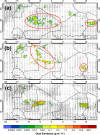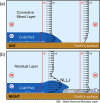The role of deep convection and nocturnal low-level jets for dust emission in summertime West Africa: Estimates from convection-permitting simulations
- PMID: 25893153
- PMCID: PMC4394720
- DOI: 10.1002/jgrd.50402
The role of deep convection and nocturnal low-level jets for dust emission in summertime West Africa: Estimates from convection-permitting simulations
Abstract
[1] Convective cold pools and the breakdown of nocturnal low-level jets (NLLJs) are key meteorological drivers of dust emission over summertime West Africa, the world's largest dust source. This study is the first to quantify their relative contributions and physical interrelations using objective detection algorithms and an off-line dust emission model applied to convection-permitting simulations from the Met Office Unified Model. The study period covers 25 July to 02 September 2006. All estimates may therefore vary on an interannual basis. The main conclusions are as follows: (a) approximately 40% of the dust emissions are from NLLJs, 40% from cold pools, and 20% from unidentified processes (dry convection, land-sea and mountain circulations); (b) more than half of the cold-pool emissions are linked to a newly identified mechanism where aged cold pools form a jet above the nocturnal stable layer; (c) 50% of the dust emissions occur from 1500 to 0200 LT with a minimum around sunrise and after midday, and 60% of the morning-to-noon emissions occur under clear skies, but only 10% of the afternoon-to-nighttime emissions, suggesting large biases in satellite retrievals; (d) considering precipitation and soil moisture effects, cold-pool emissions are reduced by 15%; and (e) models with parameterized convection show substantially less cold-pool emissions but have larger NLLJ contributions. The results are much more sensitive to whether convection is parameterized or explicit than to the choice of the land-surface characterization, which generally is a large source of uncertainty. This study demonstrates the need of realistically representing moist convection and stable nighttime conditions for dust modeling. Citation: Heinold, B., P. Knippertz, J. H. Marsham, S. Fiedler, N. S. Dixon, K. Schepanski, B. Laurent, and I. Tegen (2013), The role of deep convection and nocturnal low-level jets for dust emission in summertime West Africa: Estimates from convection-permitting simulations, J. Geophys. Res. Atmos., 118, 4385-4400, doi:10.1002/jgrd.50402.
Figures










References
-
- Ansmann A, Tesche M, Knippertz P, Bierwirth E, Althausen D, Mueller D, Schulz O. Vertical profiling of convective dust plumes in southern Morocco during SAMUM. Tellus Ser. B-Chem. Phys. Meteorol. 2009;61(1):340–353. doi:10.1111/j.1600-0889.2008.00384.X.
-
- Bagnold RA. The Physics of Blown Sands and Desert Dunes. New York: Methuen; 1941. p. 244.
-
- Balkanski Y, Schulz M, Claquin T, Guibert S. Reevaluation of Mineral aerosol radiative forcings suggests a better agreement with satellite and AERONET data. Atmos. Chem. Phys. 2007;7:81–95. doi:10.5194/acp-7-81-2007.
-
- Barthe C, Mari C, Chaboureau JP, Tulet P, Roux F, Pinty JP. Numerical study of tracers transport by a mesoscale convective system over West Africa. Ann. Geophys. 2011;29(5):731–747. doi:10.5194/angeo-29-731-2011.
-
- Belnap J, Phillips SL, Miller ME. Response of desert biological soil crusts to alterations in precipitation frequency. Oecologia. 2004;141:306–316. doi:10.1007/s00442-003-1438-6. - PubMed
LinkOut - more resources
Full Text Sources
Other Literature Sources
Miscellaneous
